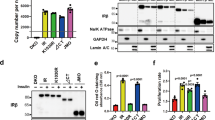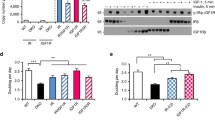Abstract
The mechanism by which insulin decreases protein degradation is unknown. We examined insulin binding and degradation (125I- [A14]insulin) and protein degradation (3H-leucine labeling) in Chinese hamster ovary (CHO) cells transfected with wild-type (WI) and mutant human insulin receptors. The ΔExon-16 mutant is missing the juxtamembrane domain that mediates endocytosis. The Δ343 mutant receptor lacks the tyrosine kinase structural domain but retains the juxtamembrane internalization domain. The mutant ΔNPEY lacks the single NPEY sequence located 16 residues after the end of the transmembrane domain. Null transfected cells (NEO) not expressing human receptors were studied as controls. The WT and ΔNPEY cells equivalently internalized and degraded insulin; Δ343 cells internalized and degraded insulin, but at a reduced rate; ΔExon-16 cells internalized and degraded significantly less insulin than the other mutants; NEO cells showed essentially no internalization and degradation. In contrast, all cell types showed the same efficacy at inhibition of protein degradation, albeit at different potencies. These results suggest insulin actions are mediated by multiple and redundant effector systems, but that receptor tyrosine kinase activity is not required for inhibition of protein degradation.
Similar content being viewed by others
References
Cheatham B, Kahn CR. Insulin action and the insulin signaling network. Endocr Rev 1995, 16: 117–42.
Saltiel AR. Diverse signaling pathways in the cellular actions of insulin. Am J Physiol 1998, 279: E375–85.
Shymko RM, Gonzales NS, Backer JM, White MF, De Meyts P. Binding kinetics of mutated insulin receptors in trans-fected cells grown in suspension culture: Application to the tyrphe 960 insulin receptor mutant [published erratum appears in Biochem Biophys Res Commun 1990, 168: 387]. Biochem Biophys Res Commun 1989, 164: 191–8.
Macaulay SL, Polites M, Frenkel MJ, Hewish DR, Ward CW. Mutagenic structure/function analysis of the cytoplasmic cysteines of the insulin receptor. Biochem J 1995, 306: 811–20.
Macaulay SL, Clark S, Larkins RG. Correlation of insulin receptor level with both insulin action and breakdown of a potential insulin mediator precursor; studies in CHO cell-lines transfected with insulin receptor cDNA. Biochim Biophys Acta 1992, 1134: 53–60.
Osterop AP, Medema RH, Bos JL, et al. Relation between the insulin receptor number in cells, autophosphorylation and insulin-stimulated ras. Gtp formation. J Biol Chem 1992, 267: 14647–53.
Rooyackers OE, Nair KS. Hormonal regulation of human muscle protein metabolism. Annu Rev Nutr 1997, 17: 457–85.
Smith OL, Wong CY, Gelfand RA. Skeletal muscle proteolysis in rats with acute streptozocin-induced diabetes. Diabetes 1989, 38: 1117–22.
Grizard J, Dardevet D, Balage M, et al. Insulin action on skeletal muscle protein metabolism during catabolic states. Reprod Nutr Dev 1999, 39: 61–74.
Mortimore GE, Poso AR. The lysosomal pathway of intracellular proteolysis in liver: regulation by amino acids. Adv Enz Reg 1986, 25: 257–76.
Lardeux BR, Mortimore GE. Amino acid and hormonal control of macromolecular turnover in perfused rat liver. Evidence for selective autophagy. J Biol Chem 1987, 262: 14514–9.
Mortimore GE, AR. Intracellular protein catabolism and its control during nutrient deprivation and supply. Annu Rev Nutr 1987, 7: 539–64.
Hamel FG, Bennett RG, Harmon KS, Duckworth WC. Insulin inhibition of proteasome activity in intact cells. Biochem Biophys Res Commun 1997, 234: 671–4.
Duckworth WC, Bennett RG, Hamel FG. Insulin acts intracellularly on proteasomes through insulin-degrading enzyme. Biochem Biophys Res Commun 1998, 244: 390–4.
Bennett RG, Hamel FG, Duckworth WC. Identification and isolation of a cytosolic proteolytic complex containing insulin degrading enzyme and the multicatalytic proteinase. Biochem Biophys Res Commun 1994, 202: 1047–53.
Duckworth WC, Bennett RG, Hamel FG. A direct inhibitory effect of insulin on a cytosolic proteolytic complex containing insulin degrading enzyme and multicatalytic proteinase. J Biol Chem 1994, 269: 24575–80.
Bennett RG, Hamel FG, Duckworth WC. Characterization of the insulin inhibition of the peptidolytic activities of the insulin-degrading enzyme-proteasome complex. Diabetes 1997, 46: 197–203.
Berhanu P, Anderson C, Hickman M, Ciaraldi TP. Insulin signal transduction by a mutant human insulin receptor acking the NPEY sequence. Evidence for an alternate mitogenic signaling pathway that is independent of Shc phosphorylation. J Biol Chem 1997, 272: 22884–90.
Berhanu P, Ibrahim-Schneck RH, Anderson C, Wood WM. The NPEY sequence is not necessary for endocytosis and processing of insulin-receptor complexes. Mol Endocrinol 1991, 5: 1827–35.
Schranz DB, Rohilla AM, Anderson C, Wood WM, Berhanu P. Insulin internalization in the absence of the insulin receptor tyrosine kinase domain is insufficient for mediating intracellular biological effects. Biochem Biophys Res Commun 1996, 227: 600–7.
Staubs PA, Reichart DR, Saltiel AR, et al. Localization of the insulin receptor binding sites for the SH2 domain proteins p85, Syp, and GAP. J Biol Chem 1994, 269: 27186–92.
Kaburagi Y, Yamamoto-Honda R, Tobe K, et al. The role of the NPXY motif in the insulin receptor in tyrosine phosphorylation of insulin receptor substrate-1 and Shc. Endocrinology 1995, 136: 3437–43.
Gustafson TA, He W, Craparo A, Schaub CD, O’Neill TJ. Phosphotyrosine-dependent interaction of shc and insulin receptor substrate 1 with the NPEY motif of the insulin receptor via a novel non-Sh2 domain. Mol Cell Biol 1995, 15: 2500–8.
Kaburagi Y, Momomura K, Yamamoto-Honda R, et al. Site-directed mutagenesis of the juxtamembrane domain of the human insulin receptor. J Biol Chem 1993, 268: 16610–22.
White MF, Livingston JN, Backer JM, et al. Mutation of the insulin receptor at tyrosine 960 inhibits signal transmission but does not affect its tyrosine kinase activity. Cell 1988, 54: 641–9.
Backer JM, Schroeder GG, Cahill DA, et al. Cytoplasmic juxtamembrane region of the insulin receptor: a critica role in ATP binding, endogenous substrate phosphorylation, and insulin-stimulated bioeffects in CHO cells. Biochemistry 1991, 30: 6366–72.
Urso B, Brown RA, O’Rahilly S, Shepherd PR, Siddle K. The alpha-isoform of class ii phosphoinositide 3-kinase is more effectively activated by insulin receptors than IGF receptors, and activation requires receptor npey motifs. FEBS Lett 1999, 460: 423–6.
Thies RS, Webster NJ, McClain DA. A domain of the insulin receptor required for endocytosis in rat fibroblasts. J Biol Chem 1990, 265: 10132–7.
McClain DA. Endocytosis of insulin receptors is not required for activation or deactivation of the hormone response. J Biol Chem 1990, 265: 21363–7.
Shibatani T, Ward WF. Sodium dodecyl sulfate (SDS) activation of the 20S proteasome in rat liver. Arch Biochem Biophys 1995, 321: 160–6.
Gunn JM, Clark MG, Knowles SE, Hopgood MF, Ballard FJ. Reduced rates of proteolysis in transformed cells. Nature 1977, 266: 58–60.
Hamel FG, Peavy DE, Ryan MP, Duckworth WC. High performance liquid chromatographic analysis of insulin degradation products from isolated hepatocytes: effect of inhibitors suggest intracellular and extracellular pathways. Diabetes 1987, 36: 702–8.
Bennett RG, Hamel FG, Duckworth WC. Insulin inhibits the ubiquitin-dependent degrading activity of the 26S proteasome. Endocrinology 2000, 141: 2508–17.
Duckworth WC, Bennett RG, Hamel FG. Insulin degradation: progress and potential. Endocrin Rev 1998, 19: 608–24.
Duckworth WC, Bennett RG, Hamel FG. The significance of intracellular insulin to insulin action. J Invest Med 1997, 45: 20–7.
Duckworth WC, Hamel FG, Peavy DE. Two pathways for insulin metabolism in adipocytes. Biochim Biophys Acta 1997, 1358: 163–71.
Stentz FB, Harris HL, Kitabchi AE. Characterization of insulin-degrading activity of intact and subcellular components of human fibroblasts. Endocrinology 1985, 116: 926.
Yamamoto-Honda R, Kadowaki T, Momomura K, et al. Normal insulin receptor substrate-1 phosphorylation in au-tophosphorylation-defective truncated insulin receptor. Evidence that phosphorylation of substrates might be sufficient for certain biological effects evoked by insulin. J Biol Chem 1993, 268: 16859–65.
Haft CR, Taylor SI. Deletion of 343 amino acids from the carboxyl terminus of the beta-subunit of the insulin receptor inhibits insulin signaling. Biochemistry 1994, 33: 9143–51.
Author information
Authors and Affiliations
Corresponding author
Rights and permissions
About this article
Cite this article
Hamel, F.G., Fawcett, J., Andersen, C.I. et al. Insulin inhibition of protein degradation in cells expressing wild-type and mutant insulin receptors. J Endocrinol Invest 26, 1088–1094 (2003). https://doi.org/10.1007/BF03345255
Accepted:
Published:
Issue Date:
DOI: https://doi.org/10.1007/BF03345255




